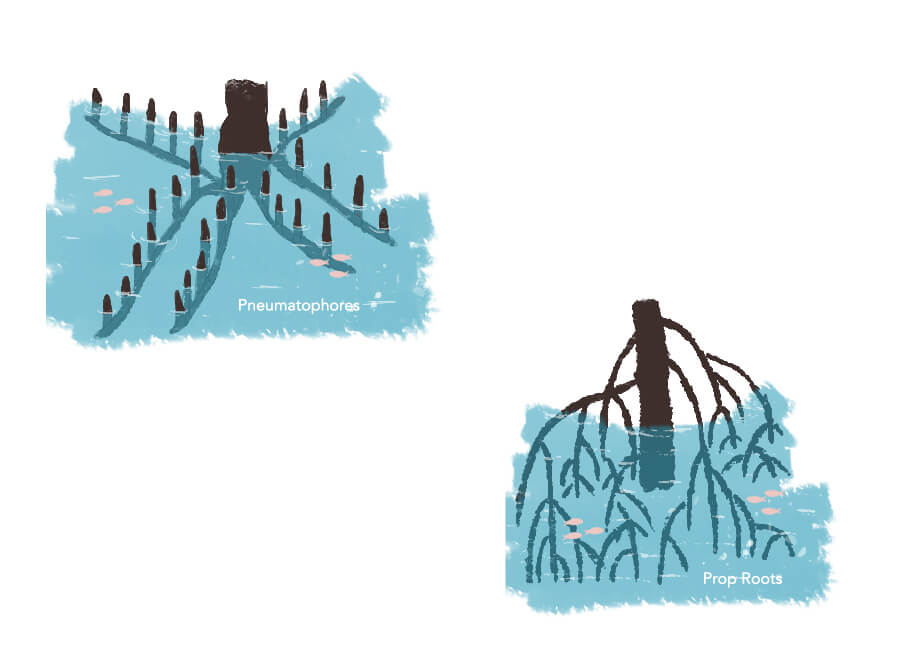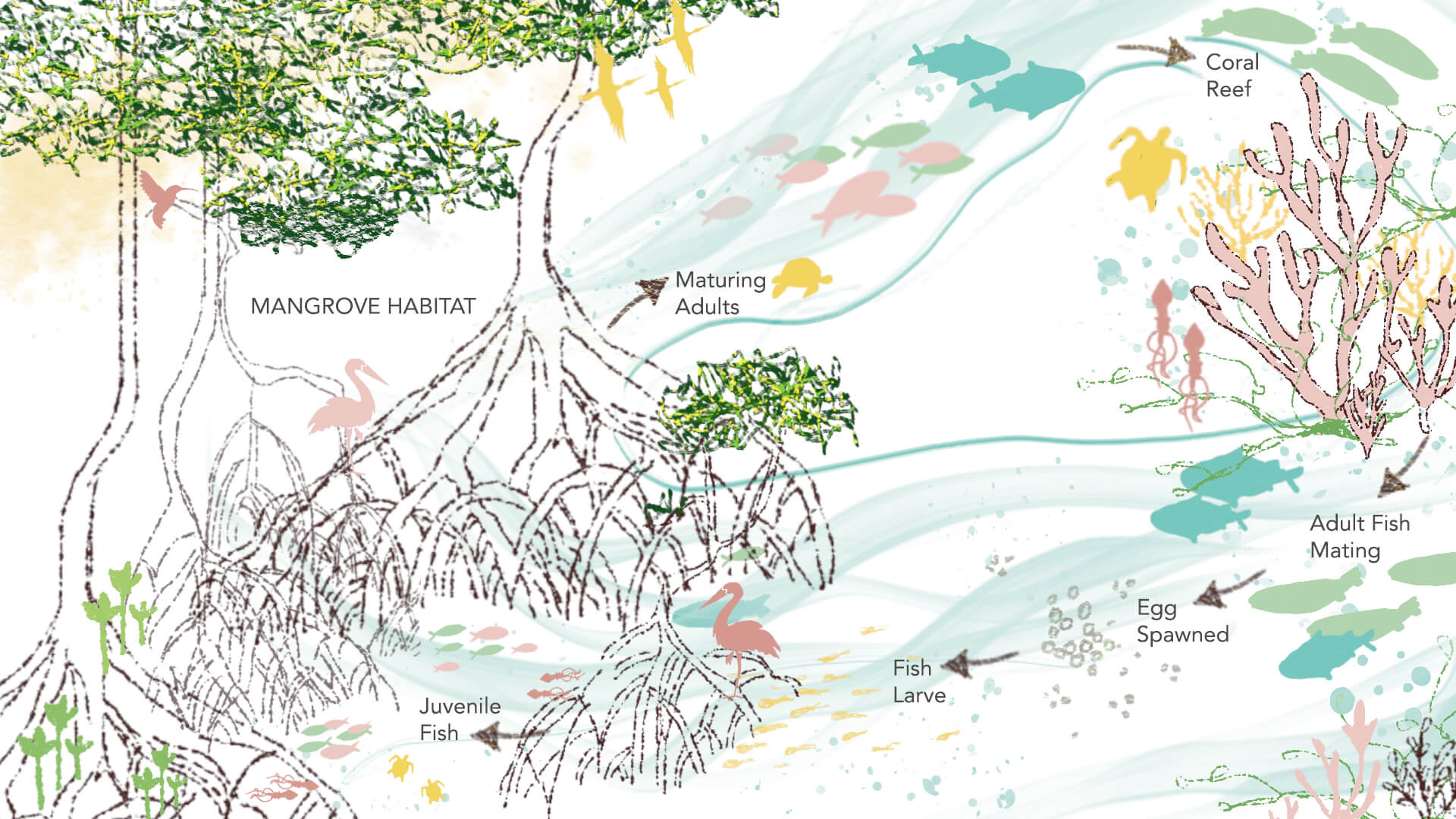In Indigenous ways of knowing, we say that a thing cannot be understood until it is known by all four aspects of our being: mind, body, emotion, and spirit
– Robin Wall Kimmerer, Gathering Moss
Illustration credit: Priyal Shah
Transcript
For as long as I can remember, I have fiercely rooted for the underdogs. It is my behavioral pattern. Be it while watching cricket matches, tennis tournaments, or any other sport or competitive winner-based events or performances, I would pick the least favored to win, but who had the gift -earnestness-commitment, and I would cheer passionately for them. And if the underdogs went onto succeed, as individuals or as a team, I would go around the whole house acting like I had just launched their careers.
Don’t ask me how many successful careers of others I feel I am responsible for, in this manner!
My first memory of the underdog of this story was in my early years in Mumbai, around 2005, when Mumbai had faced one of its worst floods. The name was mentioned so often by activists and environmentalists in the weeks that followed, that it had completely piqued my curiosity.
I was asked to go see this underdog during low tide, and I did just that. The water had completely receded. Boats anchored. And without the waves, everything appeared quiet, but I would soon discover, that wasn’t the case at all. Upon reaching, I stood for several minutes on the platform leading up to the bay, drawn into the beautiful horizon, the stillness and the beauty of the boats. But soon, I was led off the platform into the dark-coloured, slippery, squishy-squashy mud. I found my grip, and continued. Within minutes, I began to see long poky stuff jutting out like thick pencils, vertically out of the soil. Soon I observed they were everywhere. Each of them anywhere from 2-3 inches, to about 8-9 inches in length making it quite difficult to navigate through them. The more I walked into this landscape, the more the light passing through the canopy reduced. I just stood, amidst, what I later named the underdog of ecosystems – the Mangroves.
Mangroves are short bushy trees, almost like shrubs with glossy looking green leaves, and are found at the interface of soil and water, like bodies of sea, creeks, bays and estuaries, common in the intertidal areas, between high tide and low tide, which is where I was that day. I had seen nothing like this landscape before. In there, it was anything but quiet, and instead teeming with life. Fiddler crabs, Hermit crabs, Mudskippers, so many different life forms, I didn’t even know the names of, were up and about, moving hurriedly like they had a looming deadline to complete their work. With my feet coming in the way of their work, they seem to appear totally upset, just like in underground metros, in New York, London or even Mumbai. Imagine coming in the way of people going to work!
I had fallen in love. With the Mangrove ecosystem.
Today nearly a decade and half later, this love has blossomed and expanded into a much deeper understanding of this landscape, through wandering, kayaking, snorkeling, floating amidst the rich jungles of Mangroves across several tropical countries, not only admiring their phenomenal beauty, their incredible contributions to the whole marine ecosystem, but at the same time noticing how crucial a role they play at the interface of soil and water.
Like many things under: underbelly, underground hip-hop, underworld, this underdog of ecosystems, is mysterious, less known, in some ways has a cult following, and a totally acquired taste, unless of course they go viral and becomes cool, or vice-versa.
So I shall reveal to you just two of Mangroves most admirable qualities, and let us see what we can learn from them, to inform and enrich many our daily challenges. And if you don’t find them supercool after this…I shall still continue to passionately root for them. Remember, how many celebrities I am responsible for with my cheer leading!
The first quality is – Leveraging disturbances for specialization and growth
If we thought our life is challenging, we haven’t met Mangroves, that grow near the open sea, as yet. High salinity as it is sea water, almost 100% saltier than most plants can tolerate; waterlogged soil and oxygen deficiency due to being submerged in 12 hours of high tide every day; tidal pressures, strong waves and winds; and then the typhoons, hurricanes, storms. Can you imagine a more hostile environment?
In the last 114 million years of evolution (yes, they have been around for 114 million years), they have leveraged each of these disturbances to specialize and occupy a niche in the environment which many species from the plant world just haven’t been able to do so.

Illustration credit: Priyal Shah
- To manage the high salt, different species of Mangrove trees, have evolved different strategies – from excreting it through salt gland present in their leaves, to storing salt in an old leaves, so when they drops off, the salt goes out with it, and by filtering out salt from their roots by only allowing water to pass through.
- To manage exchange of gases in the oxygen-poor waterlogged soil, they put out aerial roots, sticking out of the soil, so they can still continue gas exchange, and breathe, like the ones I had seen in my first walk.
- To add strong structural support to bear the tidal pressures, winds, waves, storms, hurricanes, these very same aerial roots spread across a wide area around the trunk, making them sturdier and able to take the entire pressure, as they are the first to get hit when there is a tsunami, before water reaches other land plants, animals or humans.
Which is why there is no better natural protection to human habitats in tropical and sub-tropical countries during tsunami and storms, than these organisms.
By meeting each of these disturbances and challenges in a hostile environment with such great strategies, Mangroves have managed to occupy a niche, where there is no competition or threat, to survive and thrive.
What can we learn here, from them?
Our natural tendency is to resist disturbances and challenges. But Life enjoys teasing us with them. How can we learn to look at disturbances as openings, or opportunities for specialization? What are we currently seeing as an obstacle and stepping back, when it is actually an invitation for innovation? Maybe it is just showing us possibilities.
How can we use the wisdom offered by Mangroves to change our perspective about disturbances, and see if there is new niche waiting to be occupied by us?
The second quality– Offering invaluable ecosystem services that upholds diversity, so the whole system by default becomes strong and resilient.
This particular service Mangroves offer is highly endearing and valuable.
They are the nurseries of the ocean. What do I mean by that?

Illustration credit: Priyal Shah
By trapping sand and water between their dense aerial roots, Mangroves create the most ideal and sheltered nurseries for several juvenile coral reef species. Baby fish, baby sharks, crabs, baby turtles, and several other crustaceans, enter this safe nursery and spend their initial growing phase here. Once they become big, and are ready to face the mighty ocean, they make their way to the coral reefs.
And at the same time, these nurseries attract a wide variety of birds who wish to take advantage of this new food source, and these birds then defecate nitrogen-rich deposits into the soil. Such a rich soil in-turn fosters the growth of new mangroves. You see, how efficiently this loop works.
By staying true to their own nature, doing the work they are meant to everyday, the Mangroves offer a rich and invaluable nursery for a diversity of juvenile species, which in turn attracts further diversity and varied contribution, making the whole ecosystem stronger and more resilient. What an emergence!
What can we learn from this and bring into our lives?
Whether we are teachers, entrepreneurs, team leaders, system designers, members of a community or society, irrespective of the system we belong to, maybe we can ask ourselves – In being the gift I already am, and showing up fully, what ecosystem service can I offer in the system I am part of? How through it can I create conditions for diversity to flourish? What role or responsibility do I hold as a part of the whole, to contribute to the strength and resilience of the system?
How can we use the wisdom offered by the Mangroves to see the interconnectedness and value of each member to the whole.
See I told you, Mangroves are super cool.
Their contribution to carbon sequestration and storage is now being widely studied in the light of climate change solutions.
I end with a request:
For those of you who have access to Mangroves in your biome, which also indicates how essential this member is to such a habitat, please go and experience its beauty. Whenever you go to watch the Flamingos, or any migratory birds in mudflats or swampy areas, see if they are surrounded by these short shrubby trees, and then go explore them.
Let us all root together for this underdog of ecosystems.
Make them cool, or make them viral, up to you.
Thank you for listening, and I hope I have infected you with my love for them.
If you have experienced them, or if this story of Mangroves brought up something for you, please do share.
I really look forward to hearing from you.
Sources:
- Biomimicry Resource Handbook by Dayna Baumeister
- Asknature.org


Arun
This article also explains what your speciality means…… draw life lessons from Nature….. welcome again to our Tree walk group in Goa… love to interact and learn from you.
Arun Patil
Anjan Prakash
Thanks so much Arun. Sorry, I seem to have responded to you on whatsapp, but missed the message here.
Indeed look forward to meeting you all soon.
Usha Desai
Hi This is Dr Usha
Loved the article
Very well written..fwd on whatsapp too.
Please put up on our TAW group.Cheerd
Anjan Prakash
Dearest Usha
Thank you for reading it. What a joy to receive your message, and your beautiful words. I have put it out on TAW and once admin approves it, I think it will get published. Much much love.💚